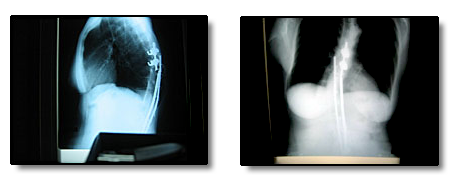Harrington rods can bend, break loose from the wires, or worse, break completely in two, necessitating further surgical intervention and removal of the rod. Once the rod is removed, corrosion (rust) is found on two out of every three.
Below, are 2 radiographs of an individual with broken Harrington rods.

These x-rays show Harrington rods that bent and broke while still inside the patient’s body. Many surgeons will refuse to operate on this condition, leaving the patient with few options to alleviate their pain and suffering.
Rod removal is usually considered when there is local pain over the site of a broken rod or from a prominent hook. Often, however, only part of a rod, or one or more prominent hooks can be removed to relieve symptoms. The spinal fusions are often extremely solid and the new bone formation encases the rods and the hooks therefore removal of the entire rod may not be possible and one or more hooks may be left behind. The wound needs 2-3 weeks to then heal unless there is additional bone grafting needed.
Even with a solid fusion, about 10% to 15% of Harrington rods subsequently fracture, due to micro movement in daily activities. When rods break within two years of operation, it usually indicates fusion failure (pseudarthrosis) and it will need to be surgically repaired by more bone grafting and possible modification of the rods.
Forums discussing complications, pain and discomfort from malfunctioning Harrington rods:
“My dad has had metal rods in his back since 1995. They are horrible. He is in so much more pain than before and now every doctor says there is nothing they can do for him b/c the rods can never come out. I am trying to get him into the mayo clinic but so far haven't had any luck. He lives in constant pain.”
Read more: Orthopedics Forum – Broken Harrington Rod
“I had/have been having a lot of back pain. Last summer I went back to the dr. that did the surgery. That is when I found out that my rod is broken. I don't know when it happened. I just know I have constant pain in my shoulder blade on up. So, unfortunately, yes the rod can break. But, I do not know the solution.”
Read more: National Scoliosis Fondation Forumus
“My daughter had her titanium Harrington rods removed on May 24th. She was two years post injury, and had constant, deep pain in her lower back. She was also constantly nauseated, making it difficult to eat.”
Read more: CareCure Forums – Removal of Harrington Rods
“I was told the best they could do as a last resort would be to to cut off pieces at each end of the break.To keep the broken halves from banging into each other.The rods were grafted/fused to my back using pieces of my hip.I was told to remove them would be extremely difficult and there was a good chance I'd be worse off afterward.”
Strauss Scoliosis Correction offers a non surgical alternative for scoliosis treatment. For more information on our program of treatment and to see if you qualify, visit our Treatment & Care page.